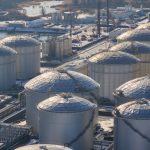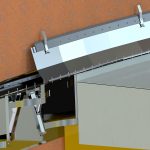RISK BASED INSPECTION
A significant part of the assets used in tank storage facilities are currently nearing the limits of the intended service life. One of the most interesting ways to deal with this circumstance is to implement service life extension. This involves “continued use of a product and/or service close to its original design lifeâ€. IT is centered around inspection and assessment of risks and total life cycle cost (LCC) of continuing the use of the product or service versus the cost of replacement.
The experienced engineers in our asset management team as well as the partners in our extensive network are capable to implement these systems in your organization. The focus of this implementation will be to create an asset management plan based on risk and reliability with an optimal balance between risk, reliability and economic considerations.
SLE is regarded as an environmentally friendly way to relieve the pressure of waste by prolonging the useful life of aging products and preventing them from being discarded too early. The only way to assure the continued economic operation of facilities with aging assets is by implementing a clever system of service life extension.
Our engineers adopt a pro-active predictive approach. This starts with a thorough investigation of the current state of the asset. The aim is to inspect with as little intrusion as possible. This includes the use of drones and inspection robots. After inspection a risk based assessment is carried out, using the best available tools in the market. The final steps in the process are in service mitigation when possible and planning an optimal maintenance scope when all in service options are exhausted.
- Determine state of the asset
- Drone inspections
Inspections with unmanned aerial vehicles also known as drones represent the next step in tank inspections. Currently drones are capable of collecting data on geometry, visuals and emission. It is a matter of time before the capabilities will be expanded to actual quantification of data. Together with our partner we can perform inspections with our UAV platform without restrictions. The licensed pilots and good link with aviation authorities put us in a perfect position to overcome any obstacle. Our state of the art software system enables efficient processing of gathered data to reach a truly efficient determination of the actual state of the asset. - In service inspection with robots
Assessment of the tank floor status is one of the main reasons for taking a tank out of service. Many aspects of a tank inspection can be done in service, but for tank floor scanning a tank needed to be emptied and cleaned. With our state of the art tank inspection robot in combination with our asset integrity specialists we are able to assess the tank floor status in service. This inspection will provide qualitative as well as quantitative data on the tank floor. It is already suitable for many light products and ongoing developments make it possible to inspect any tank with any stored product in the near future. - 3d laser scanning
Tank settlement and tilt are important causes of structural tank failure. With our laser scanning technology we can scan a tank in service and determine the actual state of settlement, tank roundness and deviations in the tank shell. This allows us to assess the tank and determine fitness for service. Measurements can be supplied in AutoCAD format. Together with our partners we can also perform finite element analyses on the date for further assessment. - Evaluation of previous inspections
When looking in detail at previous inspections it is possible to get a detailed indication of the degradation of a tank or another asset. These inspections on aging assets are a very good source of information to determine areas of interest an degradation rates to predict the current condition of the tank. Our experience with tank inspection and maintenance within reputable end users gives us the possibility to make optimal use of this important additional source of information.
- Drone inspections
- Assess the state of the asset and the remaining service life
Usually most emphasis is put on collecting data of the asset. The assessment of the state of the asset based on the information is, however much more important. This requires knowledge and experience. Taking into consideration operational limits legislation and risk involved. We offer a range of assessment services specifically tailored for this purpose.
- Determine operational and technical design limits
Our experienced engineers will determine the degradation limits of the asset based on the relevant codes such as API 653 and EEMUA 159. This wil be the basis for further assessment.- Risk based maintenance
Together with our partners we can implement a full risk based maintenance system (RBI and RCM) based on EEMUA or API standards. We believe that the successful implementation depends on an optimal combination of implementation, knowledge and data. We will make sure the maximum service life is reached against minimal risk.
- Risk based maintenance
- Define in service mitigating possibilities
- Corrosion inhibition
Quite often integrity and degradation assessments reveal unexpected results. Very high degradation speeds can threat the operability and adversely affect safety. Especially in the field of corrosion inhibition we have interesting solutions to reduce the soil side corrosion without removing the tank from service. - Monitoring causes of deterioration (humidity and settlement)
Our IIOT platform is capable of monitoring many parameters of the storage tank, for instance tilt, humidity and vibration. This enables us to detect degradation or causes of failure long before they happen. Continuous monitoring is regarded as an important mitigation for service life extension.
- Corrosion inhibition
- Determine out of service moment and out of service scope
When the mitigating actions are no longer possible the tank needs to be taken out of service. This is usually a costly operation. With the data gathered in the previous steps the optimal scope can be determined which will make sure that the tank can be taken back in service for an optimal in service period.
- Integrity scope
First and foremost the scope will be based on tank integrity. Fit for purpose calculations, RBI assessments and experience are at the basis of this scope- Equipment scope
From the RCM assessment the optimal scope op equipment replacement or refurbishment will be determined. We will serisouly consider the risks and availability requirement and only propose that scope that adds value. - Emission control scope
With sustainability on everyones top of mind environmental legislation becomes more and more important. We will make a scope compliant and possibly surpassing these requirements with the goal to contribute to a better future.
- Equipment scope



